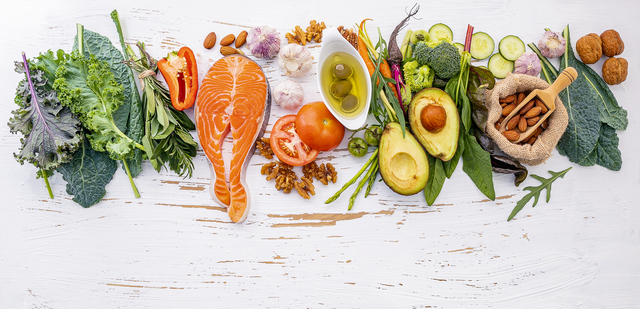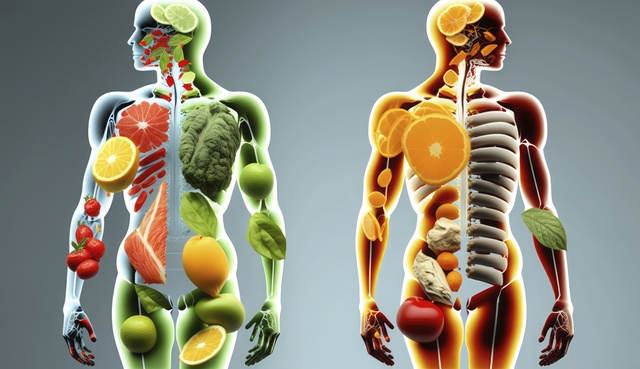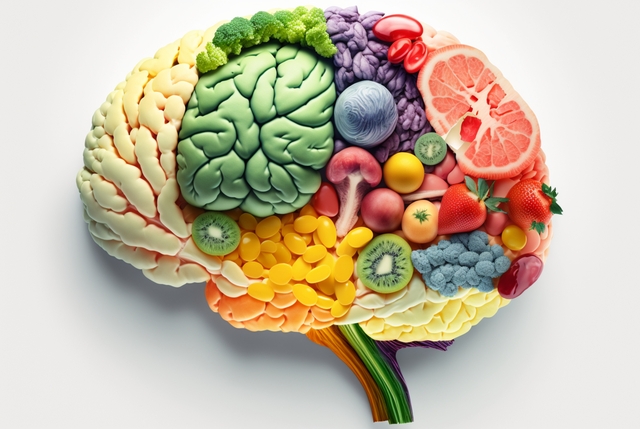Introduction
It’s time to transform your life with 10 simple Healthy Eating Habits that can lead you to a more vibrant and fulfilling lifestyle. By incorporating these straightforward practices into your daily routine, you can enhance your energy levels, improve your overall health, and even elevate your mood. From mindful eating to balanced meal planning, each one of these Healthy Eating Habits is designed to empower you on your journey toward better health. Dive in to discover how easy it can be to make significant changes in your eating habits that yield lasting benefits!
1. Prioritize whole foods over processed options daily. 2. Stay hydrated by drinking plenty of water. 3. Incorporate a variety of fruits and vegetables. 4. Practice portion control to avoid overeating. 5. Choose healthy fats like nuts and avocados. 6. Plan meals ahead to maintain balanced nutrition.

Understanding Healthy Eating Habits
Before entering into Healthy Eating Habits, it’s vital to grasp the concept of healthy eating itself.
Definition of Healthy Eating Habits
Healthy Eating Habits refers to consuming a balanced diet that includes a variety of nutrient-dense foods while limiting processed and high-sugar options. You should aim to incorporate fruits, vegetables, whole grains, lean proteins, and healthy fats into your meals for optimal health.
Benefits of a Healthy Diet
Among the many advantages of a Healthy Eating Habits are improved overall health, enhanced mood, and increased energy levels. By prioritizing nutritious foods, you contribute to better physical and mental well-being.
AHealthy Eating Habits supports various body functions, reduces the risk of chronic diseases such as heart disease and diabetes, and can even improve your sleep quality. Additionally, adopting these eating habits can lead to better weight management and enhanced cognitive function, promoting longevity and vitality.
Common Misconceptions About Healthy Eating
Healthy Eating Habits often comes with a variety of misconceptions, such as the idea that it is overly restrictive or unappetizing. You might believe that healthy options lack flavor or that you need to give up your favorite foods entirely.
This misconception can prevent you from enjoying a broad range of delicious and satisfying meals. In reality,Healthy Eating Habits is about balance and variety. You can still indulge in your favorite treats on occasion while ensuring that your overall diet is rich in nutritious ingredients. By understanding that healthy eating does not have to be boring or overly strict, you can create a sustainable lifestyle that supports your goals.
Building Healthy Eating Habits
While launching on your journey to healthier eating, it’s important to establish habits that can be easily integrated into your daily life. Focusing on planning your meals, understanding portion control, and making wise food choices will lay a solid foundation for a better lifestyle.
Planning Your Meals
With effective meal planning, you can save time and make healthier choices. Set aside some time each week to organize your meals, including breakfast, lunch, dinner, and snacks. This not only simplifies your grocery shopping but also helps you avoid impulsive decisions when you’re hungry.
Understanding Portion Control
Before you dig into your meal, it’s vital to understand portion sizes. Eating the right amount of food can help maintain a healthy weight and prevent overeating.
Also, the easiest way to control portions is to use smaller plates and bowls. This simple trick can make your meals appear more substantial, reducing the temptation to go back for seconds. Pay attention to serving sizes, and don’t forget to listen to your body’s hunger cues, allowing you to stop eating when you feel satisfied.
Choosing Whole Foods Over Processed Foods
Among the many food choices available, opting for whole foods instead of processed ones will greatly benefit your health. Whole foods contain vital nutrients that your body craves, while processed foods are often laden with harmful additives.
Meals made from whole foods, such as fresh fruits, vegetables, whole grains, and lean proteins, are packed with vitamins, minerals, and fiber. These natural options enhance your overall health and can lead to better weight management. Minimizing processed foods can also decrease your intake of excess sugar, unhealthy fats, and sodium, supporting your goal of a healthier lifestyle.
Incorporating Variety Into Your Diet
After focusing on your daily Healthy Eating Habits, it’s vital to understand how incorporating variety can elevate your nutritional intake. A diverse diet ensures that you consume a wide range of nutrients vital for your health and wellness.
Importance of Nutrient Diversity
After mixing different food groups into your diet, you’ll notice that nutrient diversity plays a vital role in your overall health. It helps in reducing the risk of chronic diseases and boosts your immune system by providing a complete spectrum of vitamins and minerals.
Tips for Adding More Fruits and Vegetables
After deciding to enhance your meals, you can easily incorporate more fruits and vegetables into your day-to-day routine.
- Start your day with a smoothie packed with fruits and spinach.
- Keep snack-sized portions of fresh vegetables handy for easy access.
- Add an extra serving of salad or vegetables to lunch and dinner.
- Try roasting or steaming a mix of seasonal vegetables for dinner.
The possibilities are endless!
Another effective way to incorporate more fruits and vegetables is to explore new recipes. You can try dishes that are rich in color and flavor to entice your taste buds. Additionally, consider joining a local farmers’ market to discover unique, seasonal produce.
- Experiment with vibrant smoothies packed with your favorite fruits.
- Incorporate colorful vegetable stir-fries for dinner.
- Make vegetable-based soups for a soothing meal.
- Create fruit salads as a refreshing treat.
The range of options is limitless!
Exploring Different Grains and Proteins

Before exploring into meal preparation, exploring different grains and proteins can significantly diversify your diet. Incorporating whole grains and diverse protein sources adds vital amino acids and fiber to your meals.
Another way to enhance your meals is by experimenting with different grains and protein sources. Consider incorporating quinoa, farro, or wild rice instead of your usual white rice or pasta. For proteins, try chickpeas, lentils, or tofu to add variety to your meals. These options not only enrich your diet but also introduce new flavors and textures that can make eating more enjoyable.
- Use quinoa as a base for colorful salads.
- Make lentil soups that are hearty and fulfilling.
- Try incorporating wild rice into stir-fries or casseroles.
- Explore different plant-based proteins for side dishes.
The key is to get creative and adventurous!
Mindful Eating Practices
Many people overlook the importance of being present during meal times. Mindful eating encourages you to pay attention to the taste, texture, and aroma of your food, fostering a deeper connection with what you consume. It promotes awareness of your hunger cues and emotional triggers connected to eating, leading to a more satisfying and healthier relationship with food.
What is Mindful Eating?
Above all, mindful eating is a practice that focuses on your experience during meals. It involves savoring each bite and being aware of your body’s sensations, ultimately helping you to recognize when you are full and preventing overeating.
Techniques for Eating Mindfully
Mindfully cultivating awareness can transform your dining experience. Start by eliminating distractions, such as your phone or television. Chew slowly and pause between bites to truly enjoy the flavors of your meal. Additionally, setting an intention before you eat can help you stay focused on your food choices and promote healthier eating habits.
Eating slowly not only enhances enjoyment but also allows for better digestion and helps you tune into your body’s hunger signals. You might discover that you feel satisfied with less food when you fully appreciate each bite, leading to reduced portion sizes and eventually, a healthier lifestyle.
The Role of Environment in Healthy Eating Habits
For your Healthy Eating Habits to improve, it is important to consider your surroundings. The physical environment in which you eat greatly influences your choices and overall experience. A calm and tidy space can help you focus on your food and make healthier decisions.
With careful attention to your environment, you can create an atmosphere that encourages healthier eating behaviors. You might find that dining in a well-lit, comfortable area reduces the urge to snack mindlessly or promotes slower eating, allowing you to fully enjoy your meals without distractions.
Staying Hydrated
Despite the many benefits of hydration, many people overlook the importance of drinking enough water throughout the day. Staying hydrated not only supports bodily functions but also enhances your overall well-being.
Importance of Water in Your Diet
Water is important for digestion, nutrient absorption, and temperature regulation. It helps transport vitamins and minerals, making it an integral part of your diet for maintaining energy levels and overall health.
Tips for Increasing Water Intake
One effective way to boost your hydration is by incorporating simple habits into your daily routine:
- Keep a water bottle with you at all times.
- Set reminders on your phone to take a drink.
- Infuse your water with fruits or herbs for added flavor.
Thou will find that incorporating these habits makes it easier to stay hydrated.
For instance, you can establish a personalized water intake goal based on your activity level and body weight. Consider drinking a glass of water before each meal or pairing it with your favorite snacks:
- Try to drink a full glass of water when you wake up.
- Replace sugary drinks with water or herbal teas.
- Explore fun drink recipes to spice up your hydration routine.
Thou will soon notice the positive effects of increased hydration on your energy and focus.
Recognizing the Signs of Dehydration
Between feeling thirsty and developing headaches, you may experience various signs indicating that your body needs more water. Lack of hydration can lead to decreased performance in physical activities and hinder cognitive functions.
Considering these symptoms can help you identify dehydration early: dizziness, dry mouth, fatigue, and dark-yellow urine. Pay attention to your body and respond promptly to these signals, as prolonged dehydration can lead to serious health issues. Ensure you’re drinking enough water daily, and prioritize your hydration for a healthy lifestyle.
Smart Snacking Strategies
All too often, snacking gets a bad reputation for contributing to unhealthy eating patterns. However, snacking can be healthy if you choose the right foods and timing. It serves as an opportunity to consume additional nutrients, maintain energy levels throughout the day, and curb hunger to avoid overeating during meals. Embracing healthy snacking can ultimately improve your overall dietary habits.
Why Snacking Can Be Healthy
Against popular belief, snacking doesn’t have to derail your healthy eating goals. Instead, it can complement your meals and provide important nutrients. By opting for smart snacks, you can maintain your energy levels and prevent cravings that might lead to less nutritious choices later on.
Healthy Snack Options to Consider for Healthy Eating Habits
To enjoy snacking while still prioritizing your health, consider incorporating options like fruits, vegetables, nuts, and whole grains. These foods are packed with vitamins, minerals, and healthy fats that support your body. Selecting nutrient-dense choices not only fuels your body but also contributes to your overall well-being.
At the next grocery visit, stock up on a variety of colorful fruits like berries and oranges, fresh vegetables such as carrots and cucumbers, and wholesome snacks like almonds, hummus, or whole-grain crackers. Having a range of tasty, Healthy Eating Habits will make snacking enjoyable and help you stay on track with your dietary goals.
Preparing for Healthy Snacking on the Go
Strategies for healthy snacking while on the move include planning ahead and preparing snacks in advance. By creating a collection of grab-and-go snacks, you can avoid the temptation of unhealthy choices during busy moments.
Also, consider preparing individual servings of snacks in portable containers to make it easier to maintain your healthy habits. Think of easy options like yogurt cups, trail mix, or sliced fruits. By setting yourself up for success with these pre-portioned snacks, you can ensure that you’re making satisfying and nutritious choices outside of your home, keeping your energy levels stable throughout the day.
Maintaining Long-Term Healthy Eating Habits
Now that you have developed some Healthy Eating Habits, it’s vital to focus on maintaining them over the long term. This requires mindful strategies and the right mindset to ensure that your progress continues in a sustainable way.
Setting Realistic Goals for Change
Any journey towards Healthy Eating Habits starts with setting achievable goals. Instead of aiming for drastic transformations, focus on small, manageable changes that can lead to lasting habits. This gradual approach makes it easier for you to adapt without feeling overwhelmed.
Overcoming Psychological Barriers
On your path to maintaining Healthy Eating Habits, you may encounter psychological barriers that challenge your progress. These could be emotional triggers or old beliefs about food that make it harder for you to stick to your goals.
With mindful awareness, you can address these psychological challenges. Identifying the emotions that lead to unhealthy choices is key. Instead of using food as a reward or comfort, find alternative outlets such as exercising or practicing a hobby. This will strengthen your emotional resilience against urges that may derail your diet.
Finding Support and Accountability
Eating healthily is often easier when you have a support system in place. Surround yourself with friends, family, or even online communities that encourage your healthy eating journey. Their positive influence can significantly enhance your motivation.
Consequently, having someone to share your challenges and victories with creates a sense of accountability. Whether it’s a workout buddy or a group that shares healthy recipes, this support can boost your resolve to stick to your long-term goals. Engaging with others not only provides encouragement but also introduces new ideas to keep your Healthy Eating Habits exciting and varied.
Conclusion
To wrap up, adopting these 10 simple Healthy Eating Habits can significantly enhance your lifestyle and well-being. By making conscious food choices, practicing portion control, and savoring your meals, you empower yourself to take control of your health.
Incorporate variety, stay hydrated, and plan your meals to ensure you’re nourishing your body and mind effectively. Embrace these habits gradually, allowing them to become part of your daily routine, and you’ll likely notice positive changes in your energy levels and overall health.
Q: What are some easy ways to incorporate more fruits and vegetables into Healthy Eating Habits?
A: To increase your fruit and vegetable intake, try to include them in every meal. Start your day with a smoothie made from leafy greens, bananas, and berries. Pack a salad with a variety of colorful vegetables for lunch. Snack on sliced carrots, cucumbers, or bell peppers with hummus in the afternoon. You can also add spinach to omelets or vegetable toppings on whole-grain pizzas, enhancing both flavor and nutrition.
Q: How can I reduce the intake of processed foods in my Healthy Eating Habits?
A: Reducing processed foods can be achieved by planning your meals and snacks around whole, unprocessed ingredients. Begin by shopping the perimeter of the grocery store where fresh produce, meats, and dairy are usually found. Consider prepping meals at home to have full control over the ingredients. Read labels carefully and choose products with minimal ingredients, focusing on whole foods like beans, grains, nuts, and seeds.
Q: Are there specific portions I should aim in my Healthy Eating Habits?
A: Portion control is important in maintaining a Healthy Eating Habits. A general guideline is to fill half your plate with fruits and vegetables, a quarter with lean proteins (like fish, chicken, or legumes), and the final quarter with whole grains (such as brown rice, quinoa, or whole-wheat pasta). Additionally, using smaller plates can help in managing portions effectively, reducing the chance of overeating.
Q: How can I make healthier food choices when dining out?
A: When eating out, look for menu items that are baked, grilled, or steamed instead of fried. Ask for dressings and sauces on the side so you can control the amount used. Incorporate healthier appetizers, such as salads or vegetable soups, before your main course. When uncertain about a dish, don’t hesitate to inquire about ingredients or request modifications that align with your healthy eating goals.
Q: What role does meal prepping play in adopting Healthy Eating Habits?
A: Meal prepping can significantly simplify the process of Healthy Eating Habits by allowing you to plan and prepare your meals in advance. Set aside time each week to cook and portion out your meals, making it easier to stick to your nutritional goals. Having healthy meals and snacks ready to go reduces the temptation to opt for unhealthy convenience foods, saving time and ensuring you maintain a balance






